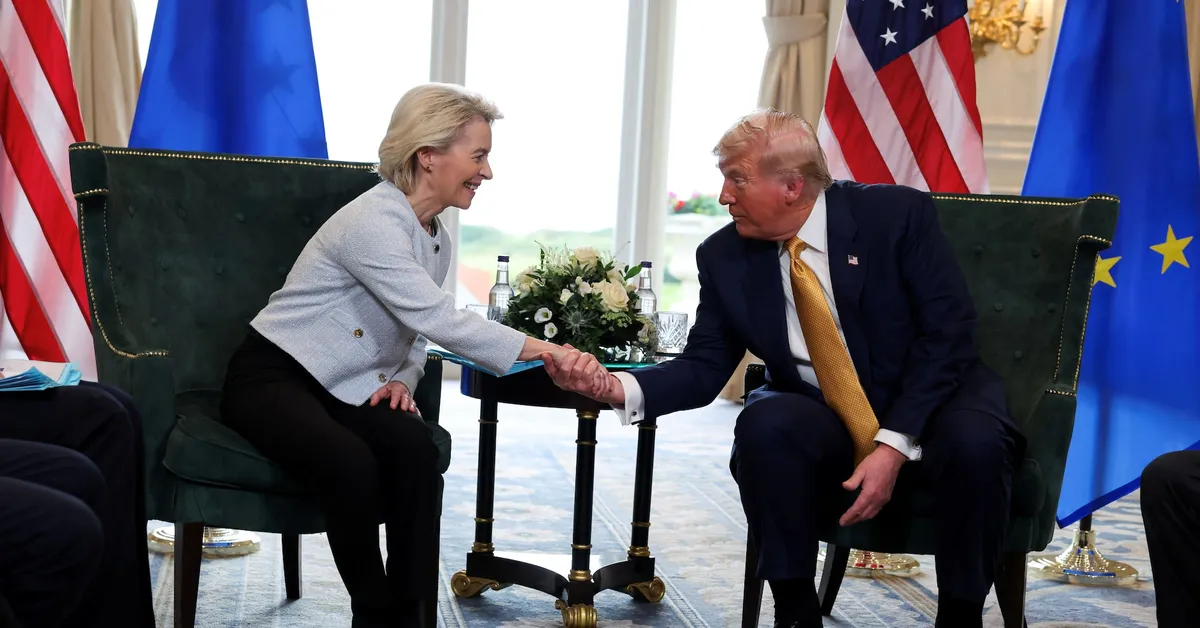
In a significant development in international trade, the United States and the European Union struck a framework trade agreement on July 27, 2023. This deal, announced at President Donald Trump's luxury golf course in Turnberry, Scotland, imposes a 15% import tariff on a majority of EU goods. This rate is half of the previously threatened 30% tariff, effectively averting a potential trade war between two economic powerhouses that comprise nearly a third of global trade.
Following an hour-long meeting, both President Trump and European Commission President Ursula von der Leyen expressed optimism about the agreement. Trump proclaimed it "the biggest deal ever made," highlighting EU plans to invest approximately $600 billion in the U.S. and significantly increase its purchases of U.S. energy and military equipment. He emphasized that this agreement would strengthen ties between the United States and the EU, which he claimed had experienced years of unfair trade practices against U.S. exporters.
President von der Leyen echoed Trump's sentiments, referring to him as a "tough negotiator." She stated that the 15% tariff would apply uniformly, describing the deal as the best outcome achievable under the circumstances. "We have a trade deal between the two largest economies in the world, and it's a big deal. It's a huge deal. It will bring stability. It will bring predictability," she said.
The agreement is expected to benefit numerous EU companies, including major players like Airbus, Mercedes-Benz, and Novo Nordisk. The framework calls for a staggering $750 billion in EU purchases of U.S. energy over the coming years, alongside substantial arms purchases. However, the baseline 15% tariff may still be viewed as excessive by many in Europe, particularly when considering initial hopes for a zero-for-zero tariff structure.
German Chancellor Friedrich Merz praised the agreement for averting a trade conflict that would have severely impacted Germany's export-driven economy and its extensive auto sector. Notably, German car manufacturers such as Volkswagen, Mercedes, and BMW have previously felt the sting of a 27.5% U.S. tariff on car and parts imports.
Despite the optimism, some officials raised concerns about the potential imbalance in the agreement. Bernd Lange, head of the European Parliament's trade committee, criticized the tariffs as disproportionate and warned that the significant EU investment earmarked for the U.S. could come at a cost to the bloc itself. Following the announcement, the euro appreciated by approximately 0.2% against the dollar, sterling, and yen.
This newly forged agreement shares similarities with a recent framework deal reached between the U.S. and Japan. However, key questions remain unanswered, particularly regarding tariff rates on spirits, a contentious issue for both parties. Carsten Nickel, deputy director of research at Teneo, remarked that this high-level political agreement lacks the depth of a fully negotiated trade deal, potentially leading to varying interpretations in the future.
While Trump confirmed the 15% tariff across the board, he also noted that the existing 50% U.S. tariff on steel and aluminum would remain in effect. Von der Leyen added that this tariff would eventually be replaced with a quota system. The agreement also stipulates that there will be no tariffs on certain categories, including aircraft and aircraft parts, specific chemicals, selected agricultural products, and critical raw materials.
As this trade framework evolves, it will be vital to monitor how well both sides adhere to the terms. From a market perspective, the deal is reassuring; having a framework is certainly preferable to a trade standoff. This agreement is positioned as a significant victory for Trump, who aims to reshape the global economy and mitigate long-standing U.S. trade deficits. Despite the accomplishment, his administration has yet to meet its goal of 90 trade deals within 90 days.
Trump has previously expressed frustration with the EU, alleging it was established to exploit the United States in trade. Upon his arrival in Scotland for the meeting, he remarked that the EU was eager to negotiate, asserting that Europe had been unfair to the U.S. The ongoing U.S. merchandise trade deficit with the EU reached $235 billion in 2024, according to data from the U.S. Census Bureau. In contrast, the EU cites its surplus in services as a partial offset to this imbalance.
In the wake of the announcement, Trump reiterated that his tariffs are generating substantial revenue for the U.S., even as economists express concerns about the potential risk of inflation. Following earlier threats of a 30% tariff on imports from the EU, which was to take effect on August 1, the deal has quelled fears of a broader trade conflict. The EU had prepared countermeasures on €93 billion (approximately $109 billion) worth of U.S. goods had negotiations failed to yield a satisfactory outcome.